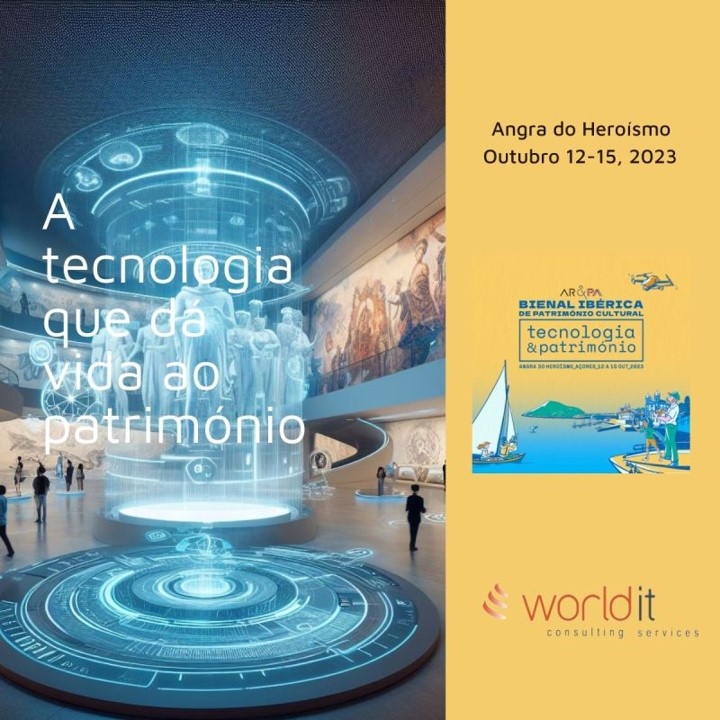
Introduction
From the 12th to the 15th of October, at the invitation of Spira, AR&PA Biennial - Heritage Fair, in Angra do Heroísmo, dedicated this year to the theme - Technology and Heritage.
First of all, our thanks to Catarina Valença Gonçalves, responsible for Spira, for the invitation and for the organization of another magnificent event, this year also associated with the celebration of the 40th anniversary of the beautiful city of Angra do Heroísmo, on Terceira Island, as a World Heritage Place.
Technology and Heritage Experience
Spira's invitation to worldIT was centered on our 20-year footprint of technological solutions for many customers in the national and international markets.
Since its beginning, worldIT has been focused on the development of corporate solutions centered on customer relationship management and its use for marketing and channels. With a very strong range of clients in the private market, the invitation to participate in the exhibition and talks also aimed to showcase other perspectives of technology applied to heritage.
Specifically, we’ve run away from the most explored and with many (and good) solutions focused on the experience of heritage visits. The technology of the visit´s experience is focused on interaction - Screens, augmented and virtual reality, and many other technological initiatives focused on the visitation space and that foster the enrichment of the experience.
Our perspective on the usage of technology is more focused on the general management around the heritage, such as visitation systems, service for customers, both prospects and already engaged, as well as communication and dissemination.
From worldIT's point of view, the approach to heritage (and we reinforced our position after the biennial) is, that technology can be an auxiliary tool to promote the "consumption" of heritage, firstly, and secondly, with a real perspective that the sustainability of the existence of heritage is also intrinsically linked to economic activities.
There are several use cases that leverage this perspective:
Customer Data Systems - The creation of centralizing repositories of audience data that allow segmentation and apropriate uniform profile.
CRM solutions - The use of efficient customer relationship systems, which allow good management, service and the actual guarantee of service (one of the worst experiences are reaching a closed door when), both of the patrimony entity but also of ancillary services that support it - catering, accommodation, transport.
Marketing and communication channels (mobile apps, portals) - The communication and usage of the right channels to reach appropriately both the heritage experimenters, as well as of the support partners mentioned in the previous point - tour operators, municipal officials, accommodation etc.
Of course, the theory is easy and there are numerous challenges. Some are clearly identifiable:
Scale - the need to connect the various actors in order to gain scale - municipalities and inter-municipal communities are by their nature candidates to lead the initiatives.
Financing - clearly the raising of funds for the development of technological systems, as well as for their maintenance as well as maintenance of heritage equipment.
Human Resources - The qualification but also the availability of human resources in regions with low density population or financial restrictions. Technology here can also be a solution, through the usage of remote home automation and surveillance systems, but also information sharing and management tools between elements.
Digital maturity and GDPR - As in almost all fields, the balance between the information processed and privacy is important to ensure a good service but keep data secure and to the right level.
Heritage has a direct impact on citizens and visitors, as well as on companies, businesses, crafts, regions and even a direct impact on the settlement of populations, contributing in a very significant way to the self-esteem of inhabitants of often neglected regions - it is important that it is monetized!
Conclusion
Our vision, as someone who does not dominate the topics behind-the-scenes and institutions related to wealth management, does not seem to be wrong. This is a perspective of a private enterprise, that works daily to generate business that is approved by clients almost exclusively on the premise that it brings value and return of investment.
It was with this vision that we’ve participated in the debate and exhibition panels, and it was this vision that seemed to us to be confirmed during the event.
Heritage has a huge potential. The use of this potential must also be harvested pragmatically with the vision that it can and must be economically sustainable, for the sake of the future.
Proper and efficient management, effective communication, and good public service of the heritage product is critical for it's future, and CRM technologies and contact channels are, as in the private business landscape, an essential component in continuous process improvement.
#CaseStudyWIT #Technological Innovation #Heritage Experience
